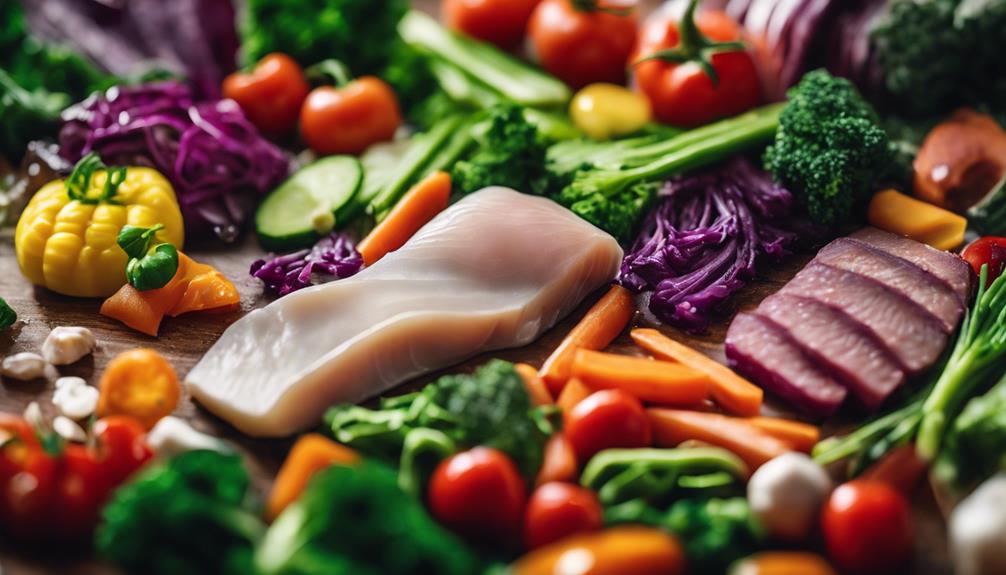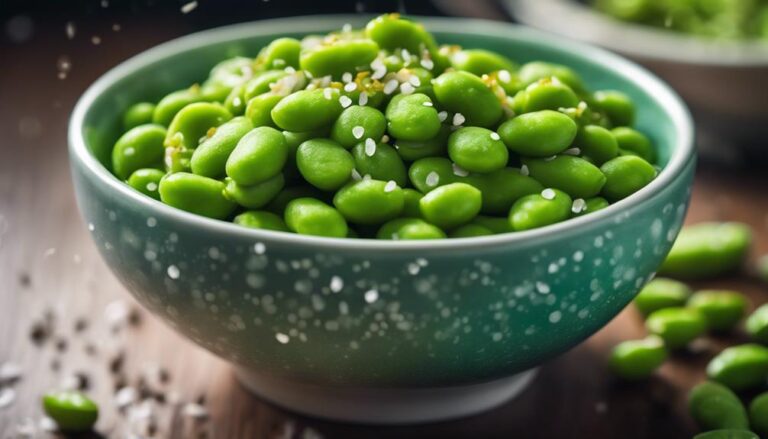Heart-Smart Eating: Mastering the Cardiac Diet With Sous Vide for Optimal Heart Health and Vitality
To master a cardiac diet with sous vide for best heart health, focus on whole grains, lean proteins, fruits, veggies, and low-fat dairy. Manage blood pressure, cholesterol, weight with fiber-rich foods. Avoid saturated fats, trans fats, added sugars, excess sodium. Sous vide cooking seals food for precise water bath cooking, retaining flavors, nutrients, ideal for heart-healthy meals. Lean proteins cooked sous vide maintain juices, flavors, and nutrients, enhancing heart wellness. Omega-3s, fiber, potassium, antioxidants are essential for heart health. Whole grains, fruits, veggies pack nutrients, reduce heart disease risk. Further exploration into this heart-smart approach holds promise for better health.
What You Will Learn Here
- Sous Vide cooking retains nutrients and flavors for heart-healthy meals.
- Focus on lean proteins, whole grains, fruits, and vegetables for optimal heart health.
- Limit saturated fats, sugars, and sodium while emphasizing fiber-rich foods.
- Incorporate Omega-3s, fiber, potassium, and antioxidants for cardiovascular wellness.
- Utilize sous vide techniques to cook lean proteins perfectly for heart-smart eating.
Understanding Heart-Smart Eating
To understand Heart-Smart Eating, prioritize a diet rich in whole grains, fruits, vegetables, lean proteins, and low-fat dairy for peak heart health. This dietary approach plays an important role in maintaining cardiovascular health by providing essential nutrients that support overall well-being. By focusing on whole foods rather than processed alternatives, you can effectively manage your blood pressure, cholesterol levels, and weight, reducing the risks associated with heart disease and stroke.
When embracing Heart-Smart Eating, it's essential to limit saturated fats, trans fats, added sugars, and excess sodium while emphasizing fiber-rich foods for digestive health. By following these guidelines, you can create a balanced plate that aligns with the MyPlate Nutrition Guide, ensuring that you consume appropriate portion sizes for excellent heart health. Understanding food labels, gradually making dietary changes, and seeking professional guidance are important steps in adopting this heart-healthy approach to eating.
Incorporating Heart-Smart Eating into your lifestyle not only benefits your cardiovascular health but also enhances your overall well-being. By making informed food choices, engaging in meal planning, and incorporating physical activity, you set yourself on a path towards long-term vitality and reduced risk of heart-related issues. Mastering the principles of Heart-Smart Eating is a significant step towards nurturing your heart and your body for a healthier future.
Benefits of the Cardiac Diet
Embrace the Benefits of the Cardiac Diet to safeguard your heart health and enhance your overall well-being. Here are four key advantages of incorporating the cardiac diet into your lifestyle:
- Reduced Cardiovascular Risk: By following the cardiac diet, you can greatly lower the chances of developing heart disease and experiencing a stroke. The emphasis on heart-smart eating habits helps fortify your cardiovascular health, keeping your heart strong and resilient.
- Improved Blood Pressure and Cholesterol Management: The cardiac diet is effective in managing blood pressure and cholesterol levels, crucial components for a healthy heart. By prioritizing nutrient-dense foods and avoiding unhealthy fats, you support your cardiovascular system's well-being.
- Enhanced Weight Management: Incorporating the cardiac diet can assist in weight control and maintenance. By focusing on wholesome ingredients and portion control, you can achieve a healthy weight, reducing the strain on your heart and overall health.
- Support for Optimal Body Function: The cardiac diet provides essential nutrients that promote efficient body function and long-term heart health. By nourishing your body with the right foods, you ensure that your cardiovascular system operates effectively, supporting your overall well-being and vitality.
Essentials of Sous Vide Cooking
By exploring the fundamentals of sous vide cooking, you can elevate your culinary skills and create delicious, nutrient-rich meals that align with the principles of the cardiac diet. Sous Vide cooking involves sealing food in a bag and cooking it in a precisely controlled water bath. This method guarantees even cooking, retains natural flavors, nutrients, and moisture, making it ideal for creating heart-healthy dishes. With precise temperature control, Sous Vide delivers perfectly cooked meals consistently. Professional kitchens and home cooks alike appreciate its ability to provide unique and flavorful cooking experiences for delicate foods, proteins, vegetables, and even desserts.
When focusing on heart health and preparing meals that align with the cardiac diet, Sous Vide cooking offers a reliable method to maintain the essential nutrients needed for cardiovascular wellness. It ensures that the food's flavors are preserved while enhancing its nutritional value, supporting overall vitality. By mastering the art of Sous Vide, you can create dishes that cater to the Mediterranean diet, which has been shown in health studies to reduce the risk of cardiovascular disease. The precision and control allowed by Sous Vide cooking enable you to cook with confidence, knowing that you're preparing meals that aren't only delicious but also beneficial for your heart health. For more information on heart-healthy recipes and techniques, see this page.
Key Nutrients for Heart Health
Ensuring your diet includes key nutrients essential for heart health is important for maintaining excellent cardiovascular function and overall well-being. Here are four essential nutrients that can support your heart health:
- Omega-3 Fatty Acids: Incorporating fatty fish like salmon and mackerel into your diet provides essential omega-3 fatty acids, which help reduce inflammation and lower the risk of heart disease. A recent study highlighted the significant benefits of these fatty acids in promoting heart health.
- Soluble Fiber: Foods rich in soluble fiber such as oats, legumes, and fruits can help lower cholesterol levels, improving heart health by reducing the absorption of cholesterol in the bloodstream. Studies have shown that a high-fiber diet can have a positive impact on heart health.
- Potassium: Bananas, sweet potatoes, and spinach are excellent sources of potassium, a mineral that plays a vital role in managing blood pressure and supporting heart function. New research suggests that increasing potassium intake can benefit heart health.
- Antioxidants: Antioxidants like vitamin C from citrus fruits, vitamin E from nuts and seeds, and beta-carotene from carrots and sweet potatoes help protect the heart from oxidative damage. Research has indicated that a diet rich in antioxidants can contribute to better heart health.
Planning Your Cardiac Diet
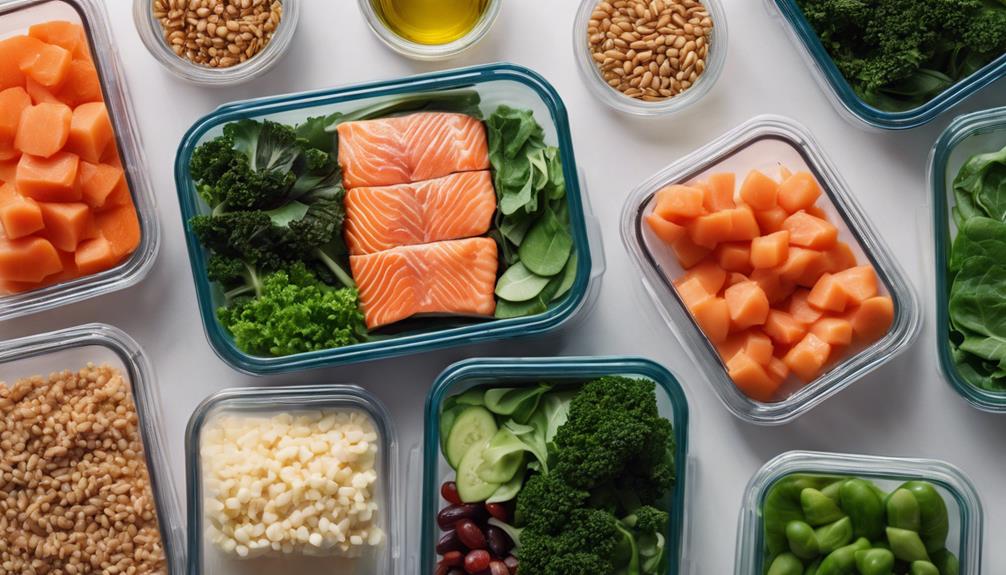
To plan a cardiac diet effectively, focus on selecting lean proteins like chicken, fish, and tofu while incorporating a variety of colorful fruits and vegetables. These choices are rich in essential nutrients and can help support your heart health. Lean proteins provide necessary amino acids without excess saturated fats, which can be harmful to your cardiovascular system. Fish, such as salmon and mackerel, are excellent sources of omega-3 fatty acids, which have been linked to reducing the risk of heart disease.
When it comes to fruits and vegetables, aim for a rainbow of colors on your plate. Different colors indicate various phytonutrients that are beneficial for your heart. For example, red fruits like strawberries and tomatoes contain antioxidants like lycopene, which can help lower blood pressure and reduce inflammation. Green vegetables like spinach and broccoli are packed with vitamins, minerals, and fiber that support overall heart function.
Additionally, incorporating whole grains like quinoa, brown rice, and oats into your meals can provide essential fiber and nutrients that contribute to heart health. These grains can help regulate cholesterol levels and improve digestion, further supporting your cardiovascular wellness. By planning your cardiac diet thoughtfully and including these key elements, you can take significant steps towards optimizing your heart health and well-being.
Best Foods for Cardiovascular Wellness
Planning your cardiac diet with a focus on incorporating the best foods for cardiovascular wellness is key to optimizing heart health. When selecting foods to support your heart, consider these top choices:
- Omega-3 Rich Foods: Foods like salmon and walnuts are packed with omega-3 fatty acids, which can lower the risk of heart disease and improve cardiovascular health.
- Fiber-Rich Foods: Incorporating oats, beans, and fruits into your diet can help reduce cholesterol levels and support heart function due to their high fiber content.
- Dark Leafy Greens: Spinach and kale are powerhouses of essential nutrients such as vitamins, minerals, and antioxidants that promote heart health.
- Nutty Goodness: Nuts like almonds, walnuts, and pistachios provide unsaturated fats, fiber, and plant sterols that benefit heart health.
Sous Vide Techniques for Lean Proteins

Achieve best results in cooking lean proteins by utilizing sous vide techniques, which involve vacuum-sealing food in a bag and cooking it in a water bath at a precise temperature. Sous Vide cooking is a method that helps maintain the natural juices, flavors, and nutrients in lean proteins like chicken, fish, and lean cuts of meat. By cooking these proteins in a controlled water bath environment, you guarantee even cooking and prevent overcooking, resulting in tender, juicy, and perfectly cooked dishes every time.
One of the significant advantages of using Sous Vide for lean proteins is that it provides a convenient way to prepare healthy meals with minimal added fats or oils, promoting heart-smart eating habits. This technique enhances the taste and texture of lean proteins while preserving their nutritional value, making it an excellent choice for those looking to improve their heart health through diet. Whether you're a fan of chicken breast, fish fillets, or lean cuts of beef, Sous Vide can help you achieve delicious results that support your cardiovascular wellness goals.
Incorporating lean proteins into your diet is essential for maintaining a heart-healthy lifestyle. With Sous Vide cooking techniques, you can elevate the flavors of these proteins while ensuring they retain their essential nutrients, making it easier to stick to your cardiac diet without sacrificing taste or texture.
Incorporating Whole Grains
By incorporating whole grains into your meals prepared with Sous Vide, you can further enhance the heart-healthy benefits of your culinary creations. Whole grains like brown rice, quinoa, and oats offer a myriad of advantages for your cardiovascular well-being:
- Nutrient-Rich Profile: Whole grains are packed with fiber, vitamins, and minerals important for heart health.
- Risk Reduction: Consuming whole grains can lower the risk of heart disease, stroke, and high blood pressure by positively impacting cholesterol levels.
- Sustained Energy: These complex carbohydrates provide lasting energy, regulate blood sugar levels, and support overall cardiovascular function.
- Weight Management: Including whole grains in your diet can aid in digestion, promote feelings of fullness, and assist in weight management, contributing to better heart health outcomes.
Research underscores the importance of whole grains in reducing the likelihood of developing cardiovascular diseases, making them an essential element of a heart-smart eating plan.
Adding Fruits and Vegetables
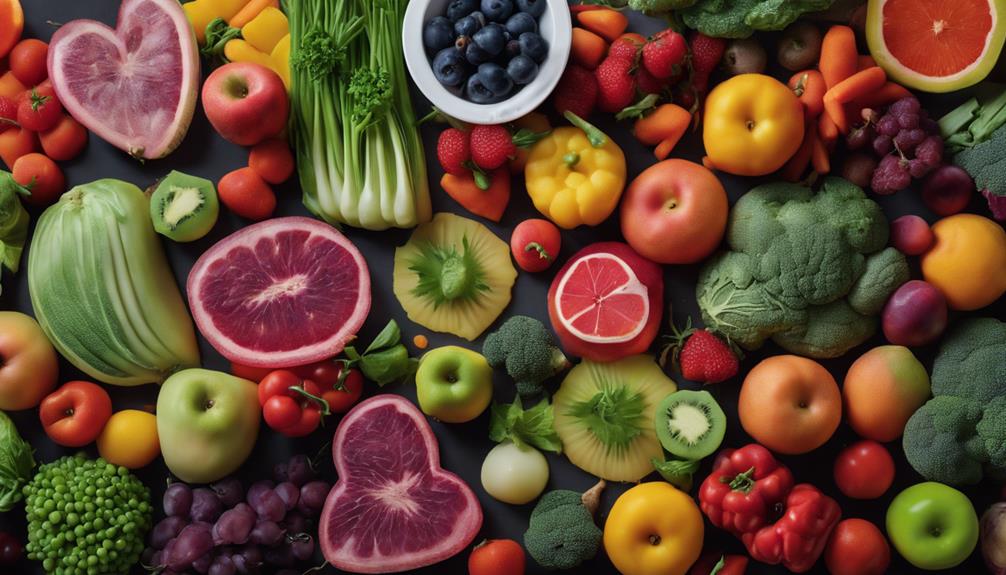
How can you maximize the heart-healthy benefits of your Sous Vide-prepared meals by incorporating an array of colorful fruits and vegetables rich in essential nutrients and antioxidants?
Fruits and vegetables are packed with vitamins, minerals, and antioxidants that play a vital role in supporting heart health. By including a variety of colorful produce in your meals, you can make sure your body receives the necessary nutrients for peak functioning.
Not only do fruits and vegetables provide essential nutrients, but they're also linked to a reduced risk of heart disease and stroke. The wide range of nutrients found in these plant-based foods can help manage blood pressure and cholesterol levels, key factors in maintaining a healthy heart.
Additionally, the fiber content present in fruits and vegetables is beneficial for digestive health and weight management. Fiber aids in digestion, promotes a feeling of fullness, and can assist in controlling weight by regulating appetite.
To make the most of your cardiac diet with Sous Vide, aim to incorporate a diverse selection of fruits and vegetables into your meals. Whether it's vibrant berries, leafy greens, or crunchy bell peppers, each colorful addition brings its unique set of heart-healthy benefits to the table. So, slice, dice, and Sous Vide your way to a healthier heart with the power of fruits and vegetables.
Recipes for Heart Health
Enhance your heart health with flavorful and nutrient-rich recipes prepared using the precise Sous Vide cooking method.
- Lean Proteins: Opt for lean proteins such as chicken and fish when creating heart-healthy dishes with Sous Vide precision. These proteins are low in saturated fats, making them ideal choices for maintaining cardiovascular wellness.
- Colorful Vegetables: Incorporate a variety of colorful vegetables into your Sous Vide recipes to boost heart health with essential nutrients. Vegetables like bell peppers, spinach, and carrots not only add vibrant colors to your dishes but also provide vitamins, minerals, and antioxidants that support overall heart function.
- Minimized Oils and Fats: Sous Vide cooking eliminates the need for excess oils and fats, promoting a heart-smart approach to meal preparation. By cooking your ingredients in a precise water bath at controlled temperatures, you can enjoy delicious meals without compromising your heart health.
- Preserved Flavors and Textures: Sous Vide cooking ensures precise temperature control, preserving the natural flavors and textures of heart-healthy ingredients. This method helps retain nutrients in foods, making it an ideal choice for crafting dishes that prioritize both taste and heart wellness.
Maintaining Flavor and Nutrition
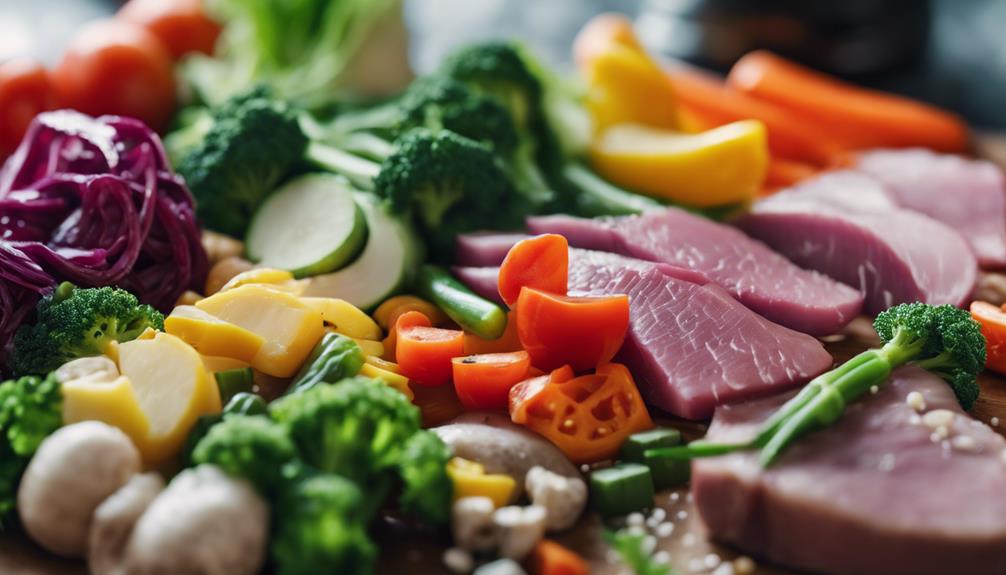
To guarantee excellent flavor and nutrition in your heart-healthy meals, mastering the sous vide cooking technique is essential. Sous vide cooking is highly effective in preserving nutrients in food due to its precise temperature control, which helps maintain the health benefits of ingredients. This method locks in essential vitamins and minerals, ensuring that your meals support heart health and overall well-being.
One of the key benefits of sous vide cooking is its ability to enhance flavors without the need for added fats or oils. By vacuum-sealing your ingredients before cooking, you can maintain the natural taste of heart-healthy foods, resulting in delicious meals that are both nutritious and flavorful. Additionally, the controlled cooking environment of sous vide ensures that proteins like lean meats and fish are cooked to perfection, preserving their nutrients and promoting heart health.
Furthermore, sous vide cooking helps to maintain the vibrant colors of fruits and vegetables, making your dishes visually appealing while also retaining their essential nutrients. This technique allows you to enjoy a nutrient-rich meal that not only tastes great but also supports your cardiovascular wellness. By mastering the art of sous vide cooking, you can create heart-healthy dishes that are both delicious and beneficial for your overall health.
Monitoring Your Heart Health Progress
To effectively track your progress in improving your heart health, regular monitoring of key indicators is essential:
- Blood Pressure and Cholesterol Levels: Regularly check your blood pressure and cholesterol levels to make sure they're within healthy ranges. High blood pressure and cholesterol are risk factors for heart disease, so monitoring these values is vital for your heart health.
- Food Diary: Keep a food diary to track your eating habits. This can help you identify patterns, such as excessive salt or saturated fat intake, allowing you to make necessary adjustments for a more heart-healthy diet.
- Physical Activity and Weight: Monitor your physical activity levels and weight changes. Increasing physical activity and maintaining a healthy weight can improve your heart health. Tracking these metrics can provide insights into your progress and help you stay on the right path.
- Health Apps and Wearable Devices: Consider using health apps or wearable devices to monitor your heart rate, exercise intensity, and sleep patterns. These tools can provide valuable data to assess your overall heart health and make informed decisions about your lifestyle choices.
Resources for Continued Learning
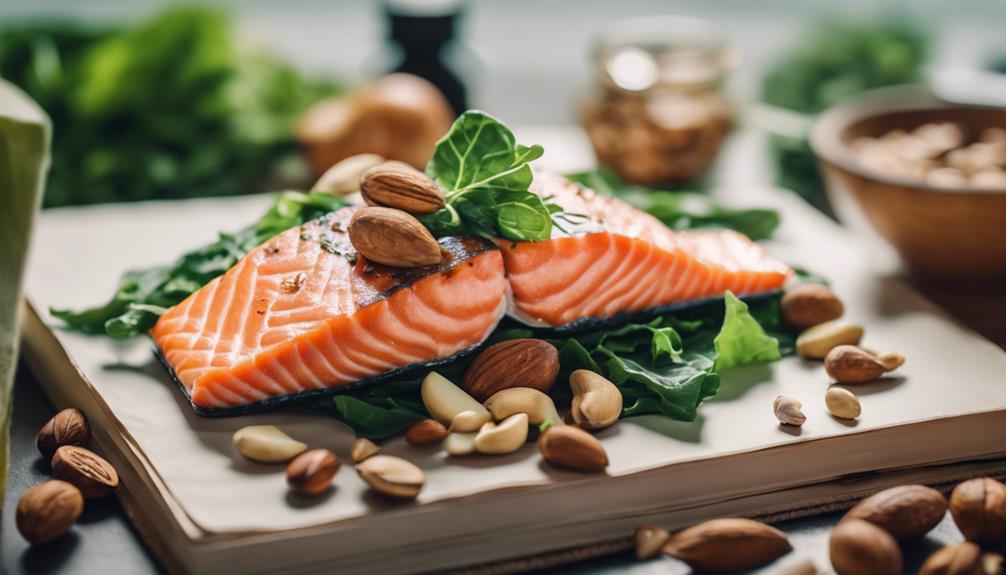
Explore a plethora of resources for enhancing your knowledge on heart-healthy cooking techniques and recipes online. Immerse yourself in online courses and webinars tailored to help you master the art of preparing delicious and nutritious meals that support cardiovascular wellness. Join support groups or forums dedicated to discussing the ins and outs of cardiac nutrition and the sous vide cooking approach. Engage in workshops or seminars led by seasoned nutrition experts and culinary professionals who can provide valuable insights into optimizing your heart health through cooking.
Delve into books and articles that explore the science behind heart-healthy eating and the precise techniques of sous vide preparation. Immerse yourself in the world of social media accounts and blogs that are solely focused on sharing practical tips and expert advice on mastering the cardiac diet with sous vide cooking. Stay connected with the latest trends and advancements in heart-smart eating by following these resources that cater to your pursuit for excellent heart health and vitality.
Frequently Asked Questions
What Is the #1 Worst Habit for Your Heart?
Smoking is the worst habit for your heart. It greatly raises the risk of heart disease and other heart problems. Tobacco smoke has harmful chemicals that damage blood vessels, reduce oxygen to the heart, and increase blood pressure.
Atherosclerosis, heart attacks, strokes, and other serious heart issues are more likely in smokers. Quitting smoking can improve heart health, lower heart disease risk, and boost overall cardiovascular well-being.
What Is the #1 Diet for Heart Disease?
When it comes to heart disease, the DASH Diet takes the lead. By focusing on fruits, whole grains, and lean proteins while cutting back on salt, added sugars, and processed foods, this diet earns top marks for heart health.
Studies show it can lower blood pressure and cholesterol, reducing the risk of heart disease. Health experts agree: following the DASH Diet is a smart move for promoting heart health through your food choices.
What Foods Can You Not Eat on the Heart Smart Diet?
When following a heart-smart diet, you should avoid high-sodium foods like processed meats, canned soups, and fast food. Limit saturated fats found in fatty cuts of meat, full-fat dairy products, and fried foods.
Stay away from trans fats commonly found in margarine, packaged snacks, and baked goods. Cut back on sugary beverages, snacks, and desserts.
Minimize refined carbohydrates like white bread, sugary cereals, and pastries to support heart health.
What Is the Number One Best Food for Your Heart?
When focusing on heart health, one of the best foods is salmon. Packed with omega-3 fatty acids, it helps reduce inflammation and lower heart disease risk.
Eating salmon twice a week can improve cardiovascular health by lowering triglycerides and blood pressure. The American Heart Association recommends fatty fish like salmon for a heart-healthy diet.
This nutrient-dense food provides essential vitamins and minerals that support heart function and overall well-being.
Conclusion
To sum up, mastering the cardiac diet with sous vide can greatly enhance your heart health and vitality.
By incorporating lean proteins, whole grains, and nutrient-packed fruits and vegetables into your meals, you can support your cardiovascular wellness while enjoying delicious and flavorful dishes.
With careful planning, monitoring, and continued learning, you can take control of your heart health and enhance your overall well-being.
Embrace the possibilities of sous vide cooking for a heart-smart approach to eating.
